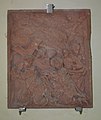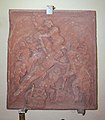Way of the Cross (Bad Camberg)
The Seven Footfalls are a way of the cross between the cemetery of Bad Camberg and the Kreuzkapelle, laid out around 1700 . Since the original panels are badly weathered, they are in the crypt of the Kreuzkapelle ▼ . Copies and information boards are attached to the seven shrines . The classicistically structured floors are over 3 meters high, made of quarry stone and clad with sandstone slabs. The Way of the Cross is a listed building .
history
The establishment of the Way of the Cross goes back to a suggestion by Trier Auxiliary Bishop Maximilian Heinrich Burmann (d. 1685). The stones were donated by the Kurtrier Oberamtmann of the Office Camberg , Wilhelm Lothar Freiherr von Hohenfeld (1651-1710) and his relatives. The bailiff had a total of 19 children (including Franz Carl Friedrich von Hohenfeld ) from two marriages and was also Imperial Councilor and Reichspfennigmeister . The sculptural work comes from the workshop of the sculptor Johann Neudecker the Elder from Hadamar . The scenes from the Passion of Christ are carved into the upper area of the shrines and the coats of arms of the donors are carved in the lower area. Today's copies come from the restoration in 1988 and by the sculptor Walter Schmitt from the F. Müller workshop in Villmar .
Station 1
▼ The 1st station ("Mount of Olives") was donated by Sophia Clara Charlotte Freiin von Hohenfeld (1648–1701). She was the bailiff's sister and lived onHof HausennearEisenbach.
"BaronIssa SophIa antIqVae strIpIs ab HohnVelD naC Xto statVam strVXerat aere sVo (Baroness Sophia of the old lineage of the von Hohenfeld erected this image for the Savior from her own resources)"
Station 2
▼ The 2nd station ("Flagellation") was donated by Carl Lothar Freiherr vonWalderdorffauf Molsberg and Isenburg (1656–1722) and his wife Anna Katharina Elisabeth Freiin von Kesselstadt. Carl Lothar Freiherr von Walderdorff lived atMolsberg Castlein theWesterwald. Anna Katharina Elisabeth Freiin von Kesselstadt was the sister of the bailiff's first wife.
"CarL a WalDerDorff et KesseLstatt elVs VXor Ista fLagrIs caesI IesV speCtaCLa ponVnt (Karl von Walderdorff and his wife, née von Kesselstatt, put this diagram on the rod-whipped Jesus)"
Station 3
▼ The 3rd station (“crowning thorns”) was donated by Johann Caspar von Bicken zum Hain from today'sHainchennear Siegen and his wife Maria Anna Kämmerin von Worms called von Dalberg. Johann Caspar von Bicken was the brother of the second wife of the bailiff.
"De genere antIqVo BiCken CasparVs aC VXor a DaLberg Xte SerVVnt tIbI CInCte Corona (from the old lineage Kaspar von Bicken and his wife, born von Dalberg, serve you, Christ, crowned with thorns"
Station 4
▼ The 4th station (“Ecce Homo”) was donated by Wilhelm Lothar Freiherr von Hohenfeld himself and his two wives Maria Anna Freiin von Kesselstadt and Maria Margaretha von Bicken.
"HoC StrVXIt CLarVs GVILheLmVs Lothar ab Hohenfelt aC prIor ConIVnX Kessel-Stadtt aLtera BIKen (This was donated by the noble Wilhelm Lothar von Hohenfeld and his paintings, the former, a born von Kesselstatt and the later, a born von Bicken)"
Station 5
▼ The 5th station ("carrying the cross") was donated by Helfried Freiherr von Croneck and his wife Maria Elisabeth Salome Freiin von Hohenfeld. This was the second oldest sister of the bailiff.
"ELIsabeth VIDVa a CroneCk ILLVstrIs ab HohnefeLDt progenIe hVC strVXIt bal VLo ChrIste tIbI (Elisabeth widow v. Croneck, a noble von Hohenfeld by birth, had this built in honor of you, Christ, the bearer of the cross)"
Station 6
▼ The 6th station (“robbery”) was donated by Count Sebastian vonHatzfeld-Gleichen(1654–1708) and his wife Ursula Elisabeth Freiin von Kesselstadt. He lived atCrottorf Castle, she was a sister of the bailiff's first wife.
"HoC CoMes ExCellen strVXIt SebastIan HatzfeLt aC a KesseLstadt nobILIs VXor elVs (This was built by the noble Count Sebastian von Hatzfeld and his noble Gemalin, a born von Kesselstadt)"
Station 7
▼ The 7th station (“battered to the cross”) is dedicated to the auxiliary bishop Maximilian Heinrich Burmann (even if the inscription gives his first name as “Peter”). The inscription reads:
"HIC PetrVs BVrMann praeCepIt saXa LoCarl tVnc sVffraganeVs treVIr honore CrVCIs (Peter Burmann, the then auxiliary bishop of Trier, had these stones set up here, in honor of the cross)"
The meaning of the chronogram VVMCIXLCVVVVICVCI is unclear.
swell
- State Office for Monument Preservation Hessen (Hrsg.): Kreuzweg In: DenkXweb, online edition of cultural monuments in Hessen
- 325 Years of the Kreuzkapelle, p. 23, online
- Leaflet "The Chapel of the Cross and the" Seven Footfalls "by the Historisches Camberg eV association
- Hans von Hatzfeld: The founders of the 7 footfalls and their families; in: Helmut Heil (Ed.): Camberg: 700 years of city rights: Contributions to local history, 1981 ISBN 978-3-87460-045-3
Web links
Individual evidence
- ^ Association for Nassau antiquity and historical research (ed.): Yearbook of the association for Nassau antiquity and historical research. (= Nassau Annals . Volume 98 ). Verlag des Verein für Nassauische Altertumskunde und Geschichtsforschung, 1987 ( on work as Reichspfennigmeister and Imperial Councilor in the Google book search).























